6.06.2018
Ever since NASA’s Voyager 1 spacecraft flew past Jupiter in March, 1979, scientists have wondered about the origin of Jupiter’s lightning. That encounter confirmed the existence of Jovian lightning, which had been theorized for centuries. But when the venerable explorer hurtled by, the data showed that the lightning-associated radio signals didn’t match the details of the radio signals produced by lightning here at Earth.
In a new paper published in Nature today, scientists from NASA’s Juno mission describe the ways in which lightning on Jupiter is actually analogous to Earth’s lightning. Although, in some ways, the two types of lightning are polar opposites.
“No matter what planet you’re on, lightning bolts act like radio transmitters -- sending out radio waves when they flash across a sky,” said Shannon Brown of NASA’s Jet Propulsion Laboratory in Pasadena, California, a Juno scientist and lead author of the paper. “But until Juno, all the lightning signals recorded by spacecraft [Voyagers 1 and 2, Galileo, Cassini] were limited to either visual detections or from the kilohertz range of the radio spectrum, despite a search for signals in the megahertz range. Many theories were offered up to explain it, but no one theory could ever get traction as the answer.”
Enter Juno, which has been orbiting Jupiter since July 4, 2016. Among its suite of highly sensitive instruments is the Microwave Radiometer Instrument (MWR), which records emissions from the gas giant across a wide spectrum of frequencies.
“In the data from our first eight flybys, Juno’s MWR detected 377 lightning discharges,” said Brown. “They were recorded in the megahertz as well as gigahertz range, which is what you can find with terrestrial lightning emissions. We think the reason we are the only ones who can see it is because Juno is flying closer to the lighting than ever before, and we are searching at a radio frequency that passes easily through Jupiter’s ionosphere.”
While the revelation showed how Jupiter lightning is similar to Earth’s, the new paper also notes that where these lightning bolts flash on each planet is actually quite different.
“Jupiter lightning distribution is inside out relative to Earth,” said Brown. “There is a lot of activity near Jupiter’s poles but none near the equator. You can ask anybody who lives in the tropics -- this doesn’t hold true for our planet.”
Why do lightning bolts congregate near the equator on Earth and near the poles on Jupiter? Follow the heat.
Earth’s derives the vast majority of its heat externally from solar radiation, courtesy of our Sun. Because our equator bears the brunt of this sunshine, warm moist air rises (through convection) more freely there, which fuels towering thunderstorms that produce lightning.
Jupiter’s orbit is five times farther from the Sun than Earth’s orbit, which means that the giant planet receives 25 times less sunlight than Earth. But even though Jupiter’s atmosphere derives the majority of its heat from within the planet itself, this doesn’t render the Sun’s rays irrelevant. They do provide some warmth, heating up Jupiter’s equator more than the poles -- just as they heat up Earth. Scientists believe that this heating at Jupiter’s equator is just enough to create stability in the upper atmosphere, inhibiting the rise of warm air from within. The poles, which do not have this upper-level warmth and therefore no atmospheric stability, allow warm gases from Jupiter’s interior to rise, driving convection and therefore creating the ingredients for lightning.
“These findings could help to improve our understanding of the composition, circulation and energy flows on Jupiter,” said Brown. But another question looms, she said. “Even though we see lightning near both poles, why is it mostly recorded at Jupiter’s north pole?”
In a second Juno lightning paper published today in Nature Astronomy, Ivana Kolmašová of the Czech Academy of Sciences, Prague, and colleagues, present the largest database of lightning-generated low-frequency radio emissions around Jupiter (whistlers) to date. The data set of more than 1,600 signals, collected by Juno’s Waves instrument, is almost 10 times the number recorded by Voyager 1. Juno detected peak rates of four lightning strikes per second (similar to the rates observed in thunderstorms on Earth) which is six times higher than the peak values detected by Voyager 1.
“These discoveries could only happen with Juno,” said Scott Bolton, principal investigator of Juno from the Southwest Research Institute, San Antonio. “Our unique orbit allows our spacecraft to fly closer to Jupiter than any other spacecraft in history, so the signal strength of what the planet is radiating out is a thousand times stronger. Also, our microwave and plasma wave instruments are state-of-the-art, allowing us to pick out even weak lightning signals from the cacophony of radio emissions from Jupiter. “
NASA's Juno spacecraft will make its 13th science flyby over Jupiter's mysterious cloud tops on July 16.
NASA's Jet Propulsion Laboratory, Pasadena, California, manages the Juno mission for the principal investigator, Scott Bolton, of the Southwest Research Institute in San Antonio. Juno is part of NASA's New Frontiers Program, which is managed at NASA's Marshall Space Flight Center in Huntsville, Alabama, for NASA's Science Mission Directorate. The Microwave Radiometer instrument (MWR) was built by JPL. The Juno Waves instrument was provided by the University of Iowa. Lockheed Martin Space, Denver, built the spacecraft.
Quelle: NASA
---
Update: 26.06.2018
.
Chaotic Clouds of Jupiter
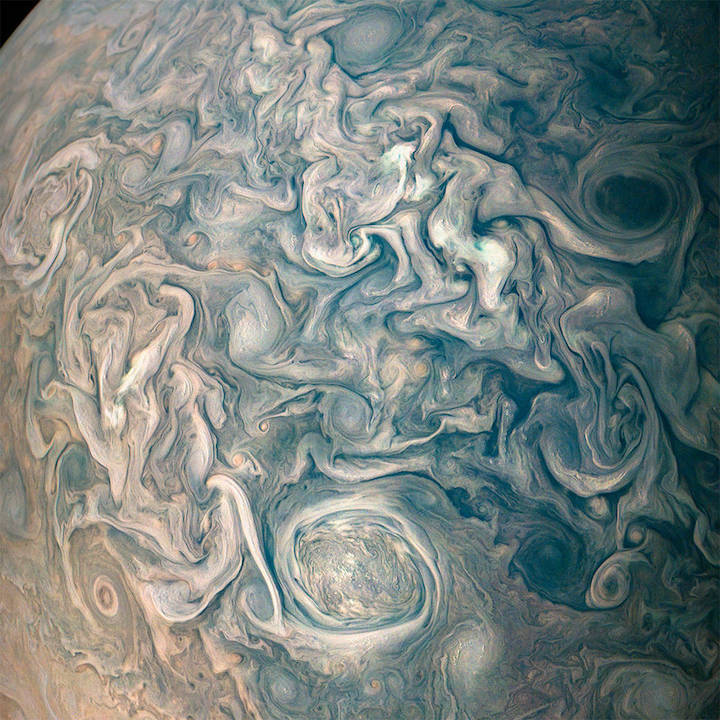
This image captures swirling cloud belts and tumultuous vortices within Jupiter’s northern hemisphere.
NASA’s Juno spacecraft took this color-enhanced image at 10:23 p.m. PDT on May 23, 2018 (1:23 a.m. EDT on May 24), as the spacecraft performed its 13th close flyby of Jupiter. At the time, Juno was about 9,600 miles (15,500 kilometers) from the planet's cloud tops, above a northern latitude of 56 degrees.
The region seen here is somewhat chaotic and turbulent, given the various swirling cloud formations. In general, the darker cloud material is deeper in Jupiter’s atmosphere, while bright cloud material is high. The bright clouds are most likely ammonia or ammonia and water, mixed with a sprinkling of unknown chemical ingredients.
A bright oval at bottom center stands out in the scene. This feature appears uniformly white in ground-based telescope observations. However, with JunoCam we can observe the fine-scale structure within this weather system, including additional structures within it. There is not significant motion apparent in the interior of this feature; like the Great Red Spot, its winds probably slows down greatly toward the center.
Citizen scientists Gerald Eichstädt and Seán Doran created this image using data from the spacecraft’s JunoCam imager.
Quelle: NASA
---
Update: 20.07.2018
.
NASA's $1 billion Jupiter probe just beamed back mesmerizing new photos of the gas giant

An illustration of NASA's Juno spacecraft flying above the clouds of Jupiter (as seen during perijove 7).NASA/JPL-Caltech/SwRI/MSSS/Kevin Gill
It’s been a busy and exhilarating couple of months for scientists who study Jupiter — and space nerds fascinated by the gas giant.
Yesterday, a team of researchers announced the discovery of 12 new Jovian moons, bringing Jupiter’s total up to 79. Last week, scientists revealed that data from NASA’s $1 billion Juno mission suggested there may be a previously undiscovered volcano on Jupiter’s moon Io. And last month, the team behind Juno figured out that Jupiter's lighting is more similar to Earth’s than previously thought — which solved a 39-year-old mystery.
But most excitingly, NASA confirmed in June that Juno, which has orbited Jupiter since July 2015, will cheat death for at least three more years. The probe was scheduled to crash into Jupiter’s clouds this month, but instead the mission has been extended until at least July 2021.
That gives scientists a chance to complete the mission's main goal: to map Jupiter’s magnetic and gravitational fields.
This work is done by flying Juno over Jupiter's cloud tops at speeds roughly 75 times as fast as a bullet. These flybys, called perijoves, happen once every 53.5 days. The most recent one (Juno's 14th perijove) occurred on July 16, and the prior flyby was on May 24.
The high-speed trips have allowed NASA to document the gas giant like never before. An optical camera called JunoCam captures beautiful images of Jupiter each time, and the space agency uploads the raw photo data to its websites. Then people around the world can download that data and process it into stunning color pictures.
Here are 13 mesmerizing images from the latest perijove, along with a few highlights from past flybys.
Quelle: BI
+++
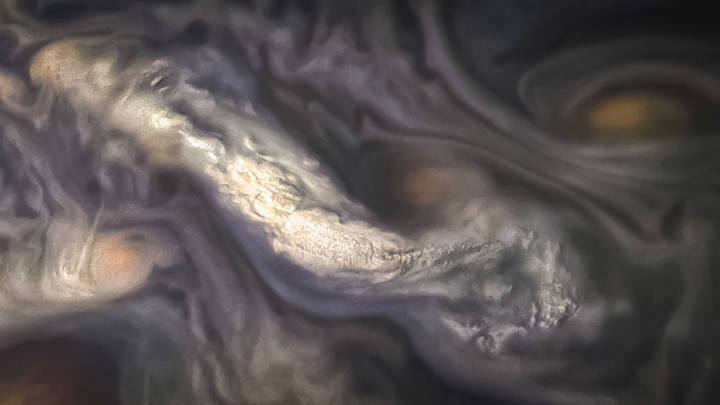
This image captures a high-altitude cloud formation surrounded by swirling patterns in the atmosphere of Jupiter's North North Temperate Belt region.
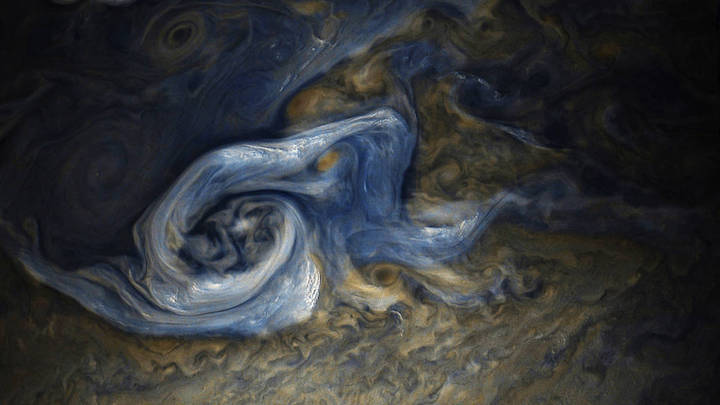
This color-enhanced image of a massive, raging storm in Jupiter’s northern hemisphere was captured by NASA’s Juno spacecraft
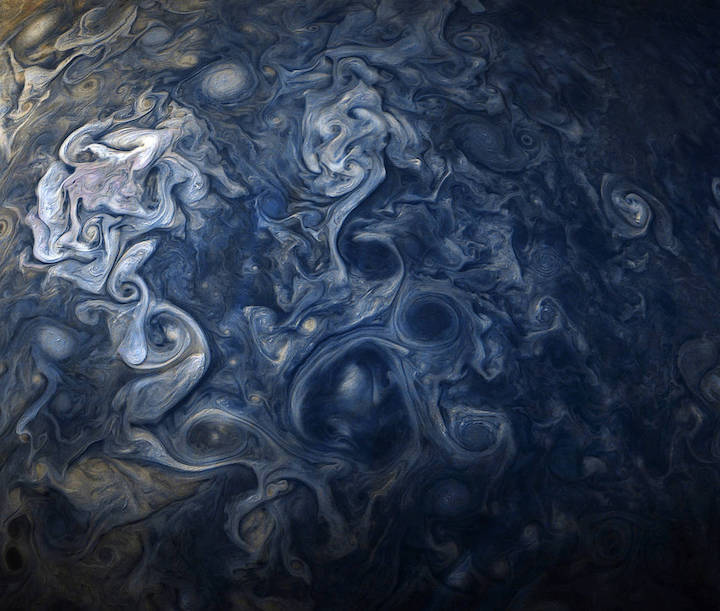
See Jovian clouds in striking shades of blue in this new view taken by NASA’s Juno spacecraft.

NASA’s Juno spacecraft was a little more than one Earth diameter from Jupiter when it captured this mind-bending, color-enhanced view of the planet’s tumultuous atmosphere.
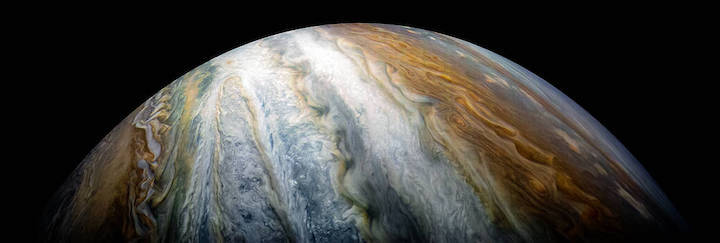
Colorful swirling cloud belts dominate Jupiter’s southern hemisphere in this image captured by NASA’s Juno spacecraft.
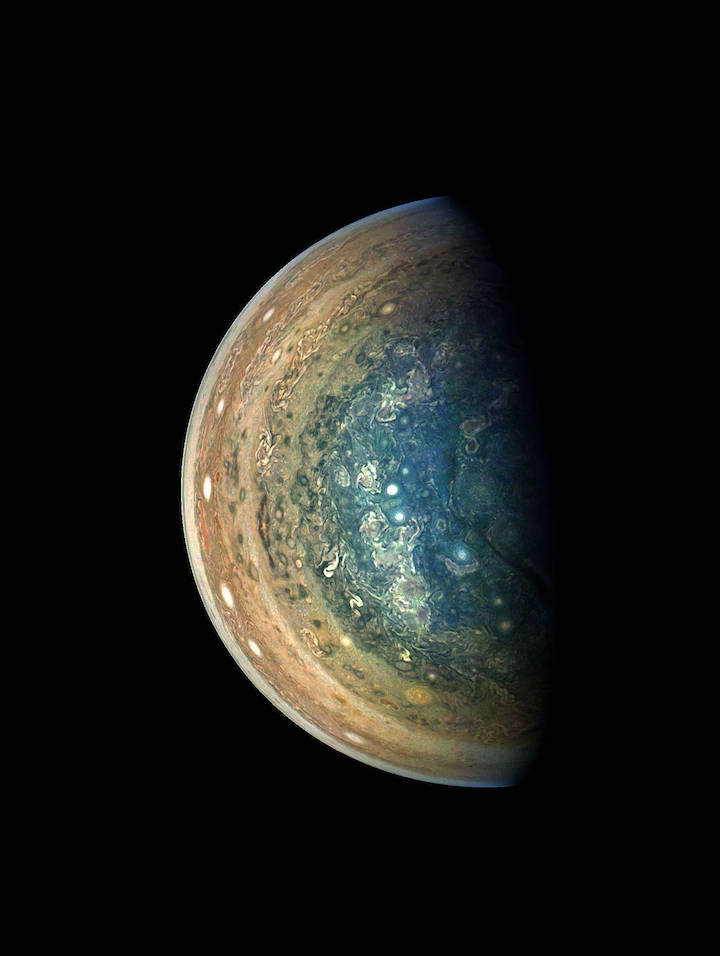
This image of Jupiter’s swirling south polar region was captured by NASA’s Juno spacecraft as it neared completion of its tenth close flyby of the gas giant planet.
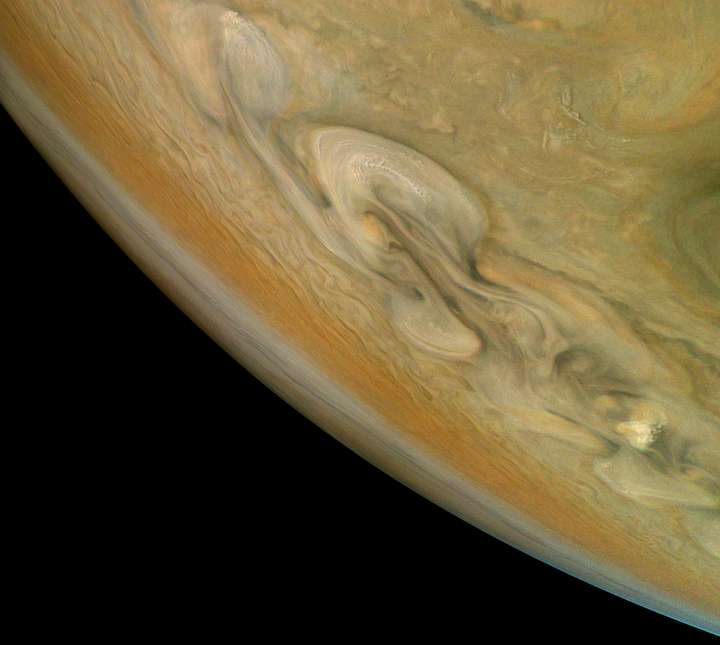
See Jupiter’s northern polar belt region in this new view taken by NASA’s Juno spacecraft.

See swirling cloud formations in the northern area of Jupiter's north temperate belt in this new view taken by NASA’s Juno spacecraft.
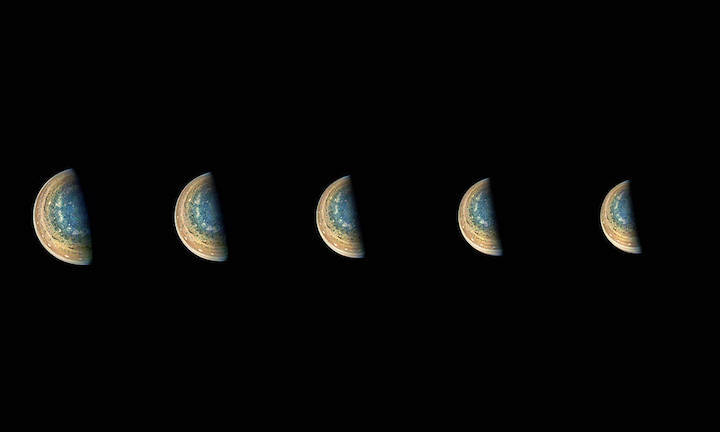
This series of images captures cloud patterns near Jupiter's south pole, looking up towards the planet’s equator.
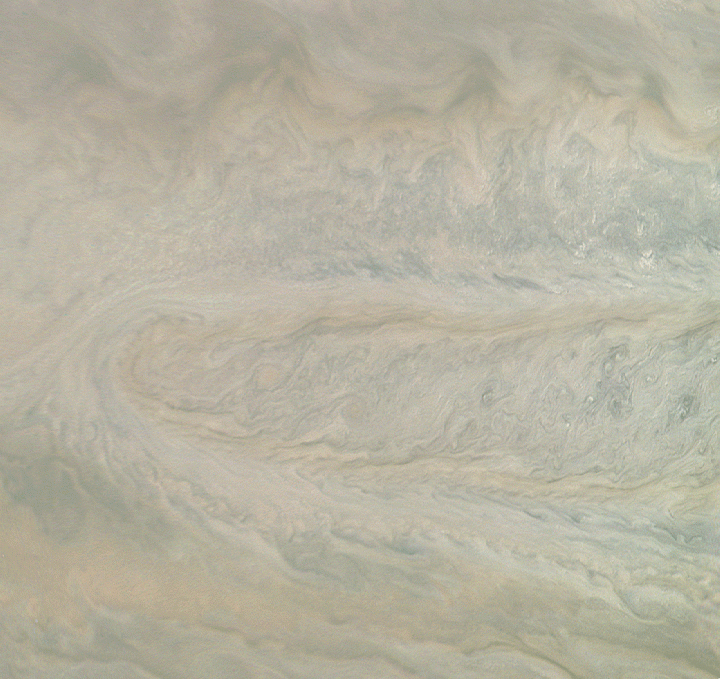
This time-lapse animation of two true-color images taken 12 minutes apart neatly captures storm movement in the southern hemisphere of Jupiter.
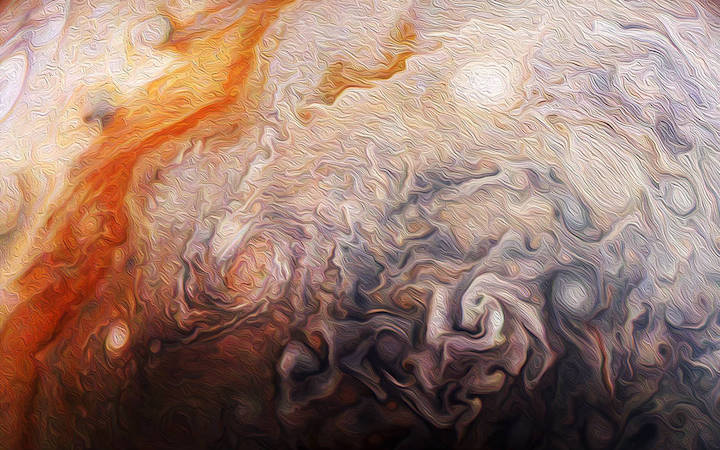
Citizen scientist Rick Lundh created this abstract Jovian artwork using data from the JunoCam imager on NASA’s Juno spacecraft.
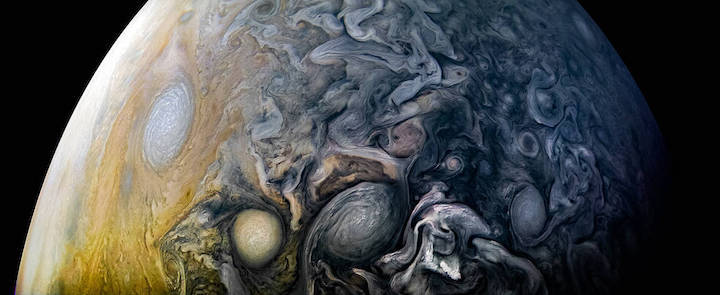
See intricate cloud patterns in the northern hemisphere of Jupiter in this new view taken by NASA’s Juno spacecraft.

This image of Jupiter’s iconic Great Red Spot and surrounding turbulent zones was captured by NASA’s Juno spacecraft.
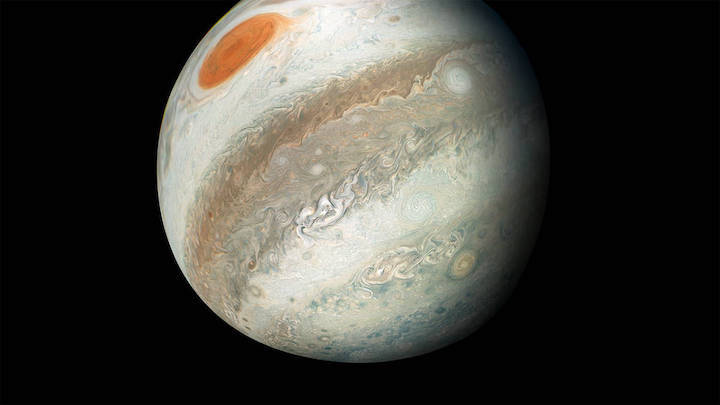
This extraordinary view of Jupiter was captured by NASA’s Juno spacecraft on the outbound leg of its 12th close flyby of the gas giant planet.
Quelle: NASA
This color-enhanced image of a massive, raging storm in Jupiter’s northern hemisphere was captured by NASA’s Juno spacecraft.


